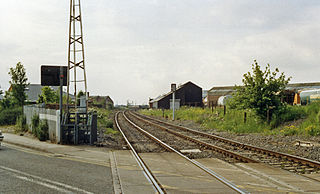Related Research Articles

The Ipswich–Ely line is a railway line linking East Anglia to the English Midlands via Ely. There is also a branch line to Cambridge. Passenger services are operated by Greater Anglia. It is a part of Network Rail Strategic Route 5, SRS 05.07, 05.08 and part of SRS 07.03. The line has previously been part of the Great Eastern Main Line.
The Edinburgh Suburban and Southside Junction Railway was a railway company that built an east-west railway on the southern margin of Edinburgh, Scotland, primarily to facilitate the operation of heavy goods and mineral traffic across the city. The line opened in 1884. Although its route was rural at the time, suburban development quickly caught up and passenger carryings on the line were buoyant; the passenger service operated on a circular basis through Edinburgh Waverley railway station.
The Lanarkshire and Ayrshire Railway (L&AR) was an independent railway company built to provide the Caledonian Railway with a shorter route for mineral traffic from the coalfields of Lanarkshire to Ardrossan Harbour, in Scotland.
There are 22 disused railway stations on the Bristol to Exeter line between Bristol Temple Meads and Exeter St Davids. The line was completed in 1844 at which time the temporary terminus at Beambridge was closed. The most recent closure was Tiverton Junction which was replaced by a new station} on a different site in 1986. 12 of the disused stations have structures that can still be seen from passing trains.

The Leicester–Burton upon Trent line is a freight-only railway line in England linking the Midland Main Line near Leicester to the Derby to Birmingham line at Burton upon Trent. The line was built by the Midland Railway, which had acquired the Leicester and Swannington Railway in 1847, improving it and extending it. It opened throughout in 1849. The line connected an exceptional number of collieries and industrial premises, and several industrial branch lines were built radiating from it. Swadlincote was already an established community engaged in industry and there was a complex of branch lines there. The passenger service on the line was discontinued in 1964, and much of the mining-based industry has closed down; quarrying is the dominant residual originating traffic. There are proposals to reopen the passenger service, and these are under review at present (2022).

The Ashby and Nuneaton Joint Railway was a pre-grouping railway company in the English Midlands, built to serve the Leicestershire coalfield. Both the Midland Railway and the London and North Western Railway (LNWR) wished to build a line on similar alignments, and they agreed to build jointly. Construction began in 1869 and the railway was opened in 1873. It linked Moira and Coalville with Nuneaton. Mineral traffic was busy, and the line formed a useful link for through goods trains. Some long distance passenger operation took place over the line, but it was never successful in carrying passengers.
The Oxford, Witney and Fairford Railway was a single track railway branch line, 22 miles (35 km) long, in Oxfordshire and Gloucestershire. It was opened in succession by two companies, the first in 1861 to connect the important woollen town of Witney to the main line network, and the second in 1873 as the rump of an ambitious scheme to connect to Cheltenham, but which ran only between Witney and Fairford. The junction with the main line was at Yarnton, north of Oxford.
The Wilsontown, Morningside and Coltness Railway was a railway opened in 1845, primarily for mineral traffic, although a passenger service was run sporadically. The line ran from a junction with the Wishaw and Coltness Railway at Chapel, to Longridge, in South Central Scotland, and it was extended to Bathgate in 1850 after takeover by the Edinburgh and Glasgow Railway. It was built to open up further coal deposits and to connect the Wilsontown Ironworks, although it did not actually reach Wilsontown. In common with the other "coal railways" with which it connected, it adopted the track gauge of 4 ft 6 in, often referred to as Scotch gauge.
References
Sources
- Wignall, C J (1985). Complete British Railway Maps and Gazetteer (1825–1985). Poole, UK: Oxford Publishing Company. ISBN 0-86093-294-X.
- "Disused Stations" . Retrieved 20 April 2008.
Notes
- ↑ although the station was closed in 2006, it remained legally open until 2020, where it was formally closed
- ↑ Although services have been suspended since 2004, the station remained legally open until 2017, where it was formally closed. This happened just as West Midlands Trains took over the operations of London Midland